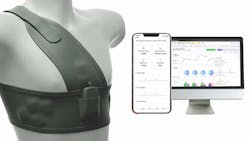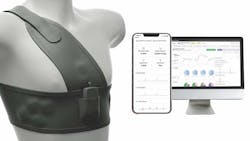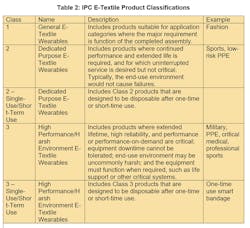New IPC Standards Help Engineers Weave Through the World of E-Textiles
Members can download this article in PDF format.
What you'll learn:
- What is the IPC?
- A look into the standards set for woven and knitted e-textiles using conductive fibers/yarns and wires, wearables, and printed electronics.
Electronic designers rely on standards for device interoperability, design reuse, quality, lower product-development costs, and increased competitiveness on a level playing field of global collaboration (see “Don’t Underestimate the Value of Standards,” Electronic Design). Even non-technical users of electronic goods benefit as well, probably without thinking about it. Unless, for example, in their new computer purchase, they see Wi-Fi specified as conforming to IEEE 802.11. IEEE standards may be the most familiar since there are some 1,300 of them.
Within the area of printed-circuit technology, IPC standards provide comprehensive coverage with more than 300 standards including both electronic design and manufacturing. Click here to see the IPC Standards Tree. IPC.org is a global trade association dedicated to furthering the competitive excellence and financial success of its members, who are participants in the electronics industry.
In pursuit of these objectives, IPC devotes resources to management improvement and technology enhancement programs, the creation of relevant standards, protection of the environment, and pertinent government relations. IPC encourages the active participation of all its members in these activities and commits to full cooperation with all related organizations (to participate, see link at the end of this article).
As a non-profit, member-driven organization and leading source for industry standards, training, industry intelligence, and public policy advocacy, IPC is the global association that helps OEMs, EMS, PCB manufacturers, and suppliers build electronics better. More than 3,000 companies around the world depend on IPC programs and services to further their competitive advantage and financial success. IPC members represent all facets of the electronics industry, including design, printed board manufacturing, electronics assembly, and testing.
The Standards
In this article, we report on standard activities for e-textiles. These materials have been known by various names: ultraflexible circuits, printed electronics, functional fabrics, technical textiles, wearable technology, smart fabric, smart textiles, and so forth. The currently published E-textiles Standard, IPC-8921, Requirements for Woven and Knitted Electronics Textiles (E-Textiles) Integrated with Conductive Fibers, Conductive Yarns and/or Wires, includes 20 new terms and definitions for e-textiles.
Table 1 is a summary of the IPC e-textile standards, including those being developed.
IPC-8921: Requirements for Woven and Knitted Electronics Textiles (E-Textiles) Integrated with Conductive Fibers, Conductive Yarns and/or Wires
As noted in IPC’s press release:
Developed through input from 140 members of the IPC D-72 Textiles Materials Subcommittee, IPC-8921 establishes classifications and designations for e-textiles integrated with e-fibers, e-yarns, and e-wires, and standardizes key characteristics, durability testing, and industry test methods. Key characteristics include electrical resistance, electromagnetic immunity, thermal conductivity, coefficient of thermal expansion (CTE), specific heat capacity, thermal shock resistance, outgassing, Tg, and melting point.
IPC-8921includes 20 new terms and definitions for e-textiles and quality assurance provisions and test frequency. It’s the first baseline compilation that merges the textile industry and electronic performance attributes in one document. When used as a benchmark of e-textile performance, e-textile products can be analyzed and compared for use in any application. Development expectations and outcomes may be shared between user and seller for transparency.
A publicly available preview shows the Table of Contents of the complete standard document. Sections on Scope and Applicable Documents, General Requirements are followed by Key Characteristics Durability, Quality Assurance Provisions, and Packaging. The published standard is available at the IPC Webstore.
But this standard was only the beginning. Next, we highlight the current state of development of other upcoming standards.
IPC-8981: Quality and Reliability for E-Textiles Wearables
As the e-textile market continues to grow, comparable quality and reliability standards across the multitude of e-textile applications become a necessity. Thus far, there are no proper e-textile reliability standards, so e-textile manufacturers look to other, related fields where such standards already exist.
Faced with the unique challenge of combining two worlds—electronics and textiles (Fig. 1)—with often very different materials, properties, and requirements, those standards often fail to meet e-textile specific needs. This situation resulted in the efforts to establish the standard IPC 8981 Quality and Reliability for E-Textiles Wearables, starting back in 2019 with a survey among industry and research stakeholders.
This survey aimed at gaining insight into which quality and reliability characteristics (mechanical, e.g., bending or abrasion resistance; or exposure, e.g., temperature or UV resistance) were deemed important for different application areas for e-textiles (fashion, sports, medical, military). Based on the results of the survey, a five-task plan to develop the standard was conceived. The following is an overview of the tasks and progress achieved to date.
Task 1: E-Textiles Wearables Terms and Definitions
To determine the scope of the standard and clarify essential terms and concepts, e-textile, wearable, and e-textile wearable were defined at the start of the standardization process. Finding the definitions was not as straightforward as it may seem. Although many people working in the textile and electronics field do have an idea of what those terms mean, those ideas don’t necessarily overlap, emphasizing the need for standardization.
Task 2: Establishment of Guidelines for Manufacturers
Conceived as an accompanying document to the main standard, the guidelines are intended to provide users with information relevant to the requirements presented in the standard. In addition, general information about e-textiles, applicable production tools and processes, as well as integration and contacting methods usable to combine electronic and textile components are provided.
The document aims at giving e-textile stakeholders coming from either the textile or electronics sector (or from an altogether different field) an overview of the respective other side necessary for the successful development of e-textile wearables. Especially for those wishing to newly expand their business toward e-textile manufacturing or start a new e-textile related venture, the guidelines can be helpful.
Even though part of the IPC 8981 standardization effort, the guidelines will be able to function as a standalone reference document for those interested to get started with e-textiles.
Task 3: Classification for E-Textiles Wearables
Due to the large number of e-textile applications and resulting variety of products with a wide range of requirements, the implementation of different quality and reliability levels was necessary for the standard. While the initial survey grouped e-textiles according to fields of application, the approach for categorizing e-textiles within the standard is slightly different.
Using existing IPC product classifications for electronics as a basis, three main product classifications for e-textiles have been defined, with a subcategory applicable to classes 2 and 3. Table 2 gives an overview of the categories and their descriptions.
At the time of writing, tasks 1 and 3 are finished, and the guidelines document exists as an extensive draft document.
Tasks 4 & 5: Creation of a Basic Standard and Establishment of Threshold Levels for Different Characteristics
The survey realized with companies and organizations designing and manufacturing, or being interested in e-textiles, at the start of our committee’s work, resulted in the establishment of the levels of importance for 22 different e-textile characteristics. The characteristics range from laundering, dry cleaning, water resistance, and stretching to biocompatibility, perspiration, and acid/alkali resistance in the function of the target product category, which are Fashion, Sports, PPE, Military, and Medical.
The survey helped us to define the main groups of characteristics important for e-textiles and define the structure of the IPC-8981 standard for Quality and Reliability for E-Textiles Wearables.
For instance, the mechanical stresses have divided into two groups: Mechanical I (IPC-8981 B series) and Mechanical II (IPC-8981 C series). The chemical, water, UV, microbes, and temperature stresses have been grouped into Exposure I (IPC-8981 D series) and Exposure II (IPC-8981 E series), and finally Cleaning (IPC-8981 F series) and Wearability & Comfort (IPC-8981 G series) groups were added (Fig. 2).
The General 8981 group (IPC-8981 A series) contains all of the testing procedures related to the general principles of measurement, the textile motherboard, sensors, electronic modules, and power-supply testing. Each specific stress type in a group corresponds to a testing method.
For example, IPC-8981 B 01: Abrasion stresses includes the testing method that should be applied to an e-textile product to test its resistance to abrasion. After testing, the e-textiles’ electrical resistance is measured using the method defined in IPC-8981 A 02: Textile motherboard, and finally the master document is consulted to define the e-textile product class (1, 2, 2a, 3, or 3a).
To date, task 4 has been finalized and task 5 is focused on the creation of basic standards and establishment of threshold levels for the different characteristics. The structure of the IPC 8981 sub-standards is given in Figure 2. The drafts of test methods and the master documents are currently finalized.
The next step will be to send all necessary documents to academic and industrial laboratories worldwide that will validate our test methods and verify the threshold levels aiming at the definition of the products’ classes. Laboratories will first have to identify what characteristics they’re interested in. Then the corresponding test methods and master document will be sent to them by IPC to assess the quality and reliability of their products and verify that if they belong to the class where they would like to position them in.
Their feedback in the form of reports and a questionnaire will be sent back to IPC and will help us improve the IPC 8981 Quality and Reliability for E-Textiles Wearables document.
The task group has a goal of completing this standard by the end of 2022.
IPC-8952: Design Standard for Printed Electronics on Coated or Treated Textiles and E-Textiles
Printed electronics on flex are at the heart of electronics devices prevalent in the fields of wearable monitoring devices, interactive consoles for entertainment and communication, solar cells, RFID tags and antennas for inventory tracking, OLED display screens, and lighting devices.
Textile is a ubiquitous material and a flexible substrate for fabricating printed electronics. Printed electronics on textile is an additional layer of functionality integrated into this ubiquitous material present in our apparel, upholsteries, and accessories.
The goal of the IPC-8952 standard is to establish specific requirements for the design of printed electronic applications (design details, materials, test requirements, mechanical properties, physical properties, thermal management) on textile as a substrate. The standard also established the specifications for methodologies of component mounting and interconnecting structures on coated or treated textile substrates. It aims to introduce a common design language and guidelines for use between user and supplier for any given e-textiles with printed electronics.
While standards exist for flexible printed electronics, they don’t consider the variations brought in by coated or treated textiles that are otherwise not seen in a standard flexible substrate. These variations are four-way stretchability, surface roughness, breathability, effects of moisture, coefficient of thermal expansion (CTE), edge effects due to textile manufacturing, and finishing process.
The list of design considerations and guidelines covered in this standard include applicable good design practices from the printed electronics on flexible substrate standards, such as IPC 2292 and IPC 9257. The standard drafting process is scheduled to finish in April of 2022 and then go for an industry review.
IPC-8971: Requirements for Electrical Testing of Printed Electronics E-Textiles
One of the main functionalities of printed-electronics e-textiles is the electrical function of the circuits in the printed electronics. The functionalities related to the printed conductive traces are electrical connectivity, electrical insulation between adjacent printed conductive traces, and leakage current through a given dielectric layer between adjacent printed traces. These originate from their trace width and thickness, distance between the adjacent traces and the thickness of the dielectric layer.
The IPC-8971 standard outlines the rules for determining adjacent printed conductive traces and type of adjacency using the CAD/CAM drawings of the printed circuit. Based on this determination, the testing requirements are defined using test methodologies such as resistive continuity or isolation, indirect isolation and continuity (by signature comparison of capacitance, RF, impedance), and testing of accessible midpoints. The end-product classifications for electronic devices—Classes 1, 2 and 3—also are considered for defining the test requirements.
The standard provides guidance on considerations for electrical test setup, test techniques, and test equipment. A template for Test Certificate of Conformance is included along with guidance on traceability and statistical process control (SPC) for electrical testing operations. The task group has a plan to complete this standard via ballot by summer 2022.
Looking to the Future
When e-textile circuitry is combined with flexible components enabled by 2D and 3D nanomaterials like graphene, nanowires, nano coils, and advanced printing techniques, we will see new applications beyond health and fitness sensors now entering the market. As this technology continues to develop, you will want to be aware, and make use, of the body of knowledge incorporated into the different standards.
The IPC D-70 standards committee on e-textiles has many activities underway besides those highlighted in this article. All interested parties are invited to participate. There’s no cost or obligation to participate, and all of the groups meet primarily via web meetings to enable the most participation. You can get involved in the IPC E-Textiles initiative today. Read more, including how to sign up, at IPC E-Textiles Initiative - Get Involved Today.
About the Author
Roger L. Franz
Environmental Sustainability Advocate and Contributing Author
Roger Franz has served as Principal, Engineering IT at TE Connectivity, Research Engineer at UL Environment, and Group Leader and Design for Environment Manager at Motorola. In addition to product environmental compliance and standards, his passions include new product development, quality, and technology research. His papers have appeared in several industry journals. He has had over a dozen article published in Electronic Design. He holds a BA and MS in chemistry from Grinnell College and Northwestern University, respectively.




